Cloth Paper Scissors is a great mag, offering articles and fabulous artwork. It comes out every second month and for $34.95 for a 12-month subscription, this is subscription is great value.
Looking for inspiration…?
Altered Books – Removing and Gluing Pages
In the previous article we discussed what an altered book is and its history, what to look for when choosing an altered book and where you may be able to find them.
To recap on choosing a book: it needs to be in good condition and it must have page sections have are sewn in. To check the construction of the book, hold the book up so you can see the inner part of the spine and where the pages touch it; if you can clearly see the page sections (the little books within the bigger book) then it will have been stitched. To check further, carefully open the middle of one of the sections. If you can see cotton or thread, then the book has been stitched and is exactly what you are looking for.
In the second part of the Altered Books in Mixed Media Arts series, we will look at the technique of removing and gluing pages used to prepare the book before getting started.
Preparing your altered book
If your chosen book is dusty, it is worth wiping it down with a cloth to remove most of the dust. To warm the book up, open it gently, somewhere in the middle and carefully flex or open and close the book to get it moving. This is particularly important if your book is brand new and hasn’t been worn in.
Removing pages
As we begin to alter our book and add paint and papers and embellishments, the size of the book will grow. Often this is part of the charm of a finished altered book; it’s so full that it barely closes.
In starting out, we can help the book by removing some pages and gluing others together. This reduced the overall bulk of the book and creates thicker pages. Firstly have a quick look through the book and see if there are any pages that catch you eye; a fantastic heading or font, a lovely picture that could be incorporated into the design. These are the pages you will want to keep. Mark them with a post-it note, so they are easy to find during the next step.
Take a lead pencil and a sharp craft knife or scalpel (as we are cutting in close to the spine, it helps if the knife is a smaller one). In between the pages you want to keep, select four pages (two spreads) to begin the removal / gluing process. The middle two pages need to be cut out, parallel to the spine, leaving about half an inch (1.5cm). On the outer two pages, that now face each other, pencil a small “G” (for glue) onto the pages, to remind us that these are the pages to glue together.
Move through the book, between the pages you want to keep and remove quite a few pages (as a guide, about a quarter of the pages will be removed) and mark the pages to glue.
Don’t throw out the removed pages. These can be used later to create background papers or words used for embellishments or to add texture. As these removed pages are the same paper with the same font and format, it makes it easier to integrate these pages into our altered layouts.
Gluing pages
Now we are ready to glue our newly made sections together. Gluing pages together give us a thicker substrate to start our project. Gluing can be a frustrating process, especially if you want it to be “prefect”, so remember that this isn’t a precise art and any imperfections will add character to our final mixed media art piece.
I use a gel medium for this type of gluing; it sticks well but does take some time to dry, so it’s not the best if you are in a hurry. Start by brushing the glue along the middle of the two removed pages and ease these together. Then coat the outside of the stumps and one whole page that is to be stuck together. Carefully ease the second page up, starting from the spine out. Work from the middle out, removing bubbles as you go.
These pages need to be stuck at the right angle to the spine, so that it will close. You need to be mindful of this when bringing the pages together.
Repeat with another one or two sets of pages, then close the book, put it on a flat surface (the floor works well) sit something heavy on it and leave it to dry. After a day or two, you may need to open the book up and sit it on its end, with pages spread, leaving it to dry for a while longer. This is necessary when using gel medium or if the weather hasn’t been really warm. It needs air to circulate to fully dry.
In the next article we will continue to discuss preparing our altered books by using gesso, how to choose a theme and where to looking for inspiration.
Happy creating!
…
Altered Books for Mixed Media Art
Altered books are one of the exciting areas within Mixed Media Arts. This article will provide information as to what to look for when choosing a book to alter and some of the background to altered books.
What is an altered book?
An altered book is an old book, often no longer needed in its original form or for its original content, that has been turned into a work of art. Many mixed media art techniques can be used to create this artwork, from painting, stamping, journalling and collage. The final project may be a book with a common theme or it could be simply a “technique book” where many different mixed media techniques are tried. Books can be created by one artist or a group of artist may come together to do a “round robin “project.
History of Altered Books
Altering or reusing books and parchment has been around for a long time. When parchment was a scarce commodity, the monks would scrape off old writings and prepare the parchment for reuse. This is known as a palimpsest. Illustrations were also saved from the old manuscripts and reused in the new texts.
Modern altering came into vogue from the 1960’s with British artist Tom Phillips, who created his “treated book” using a Victorian novel by W.H. Mallock A Human Document. More information can be found here: Humument
These humble beginnings have created the phenomenon which we see today.
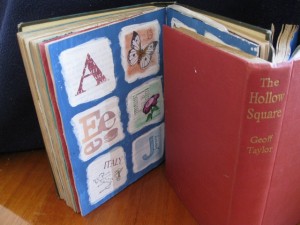 Choosing a Book to Alter
Choosing a Book to Alter
Firstly, as artists, we would never wreck a book of significant value or one that can still serve its original purpose.
The key to choosing a book to begin your altered book project is to ensure it is study enough to undergo the rigours you will put it through with your painting and gluing. It needs to be in fairly good condition, with the spine intact and pages mould free.
Next we need to check that the page sections have been sewn in. Newer books that have the pages glued in will not stand up to the altering process. To check the construction of the book, hold the book up so you can see the inner part of the spine and where the pages touch it; if you can clearly see the page sections (the little books within the bigger book) then it will have been stitched. To check further, carefully open the middle of one of the sections. If you can see cotton or thread, then the book has been stitched and is exactly what you are looking for.
Books with glued pages can still be pulled apart and used as background and collage pages with interesting fonts. Any illustrations can also be used in other projects. The covers of the book can be used as a substrate for other projects. There are many uses for these books; but we will not use them as the basis for an altered book.
Where Do I Look for Books to Alter?
As the book is becoming a work of art, it no longer holds its original value, so these books can be bought fairly cheaply. Church fairs, garage sales and opportunity shops are great places to keep an eye out for books. Discount book stores can also be treasure troves.
I will look for books with interesting pictures and fonts. Or books of a large size, which are especially good to technique books, are always a prize find.
We will cover the techniques of getting started with an altered book in the next article.
In the meantime, keep an eye out for those alterable books and…
Happy creating!
~*~*~*~*~*~*~*~*~*~*~*~*~*~*~*~*~*~*~*~*~*~*~*~*~*~*~*~*~*~*~*~*~*~*~
For further inspiration, have a look at “Altered Art: Techniques for Creating Altered Books, Boxes, Cards & More” by Terry Taylor. This book is filled with photographs and the projects are amazing.
~*~*~*~*~*~*~*~*~*~*~*~*~*~*~*~*~*~*~*~*~*~*~*~*~*~*~*~*~*~*~*~*~*~*~
…
Creating your own background
Start with a piece of cardboard – this one is from a cereal box, cut into quarters. Then a layer of gesso is added and allowed to dry.
Add the first colour. The intention here was to have the colour radiating out and fading around the circle. The gesso underneath allows the paint to be thinned out and removed, using a dabbing motion with a cloth.
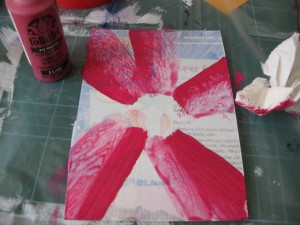
Then the second colour was added.
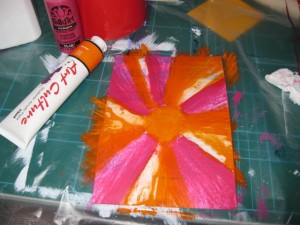
As this colour combination was a little bright, gesso was then added to tone it down and tie the pattern together. Again this layer was blotted to remove some of the gesso to make it thinner in the centre.
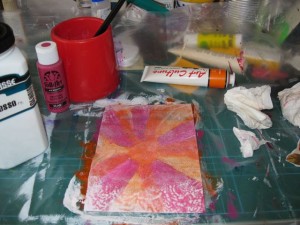
To complete the background, some stamping was added.
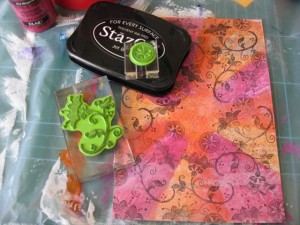
Then your background is ready to add images, text and embellishments.
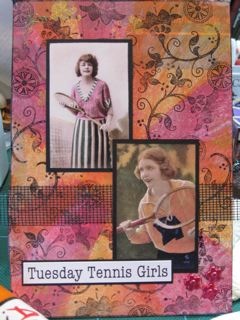
All of these pieces were stuck on with double sided tape. Images from Go Make Something.
Happy Creating!
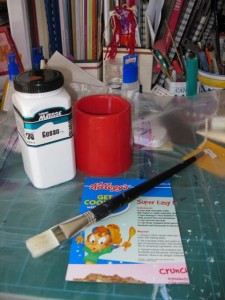
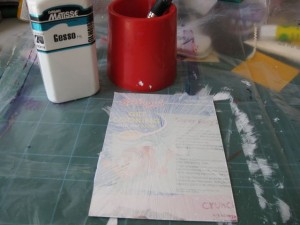



Recent Comments